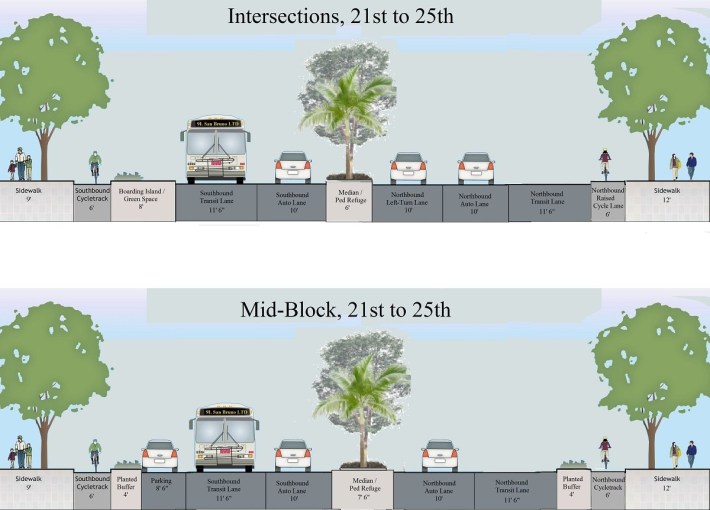After listening to city planners say there's no practical way to redesign Potrero Avenue with protected bike lanes and two transit lanes, Josh Handel didn't buy it.
Handel shared a plan in the Streetsblog comments that includes protected bike lanes and two transit lanes wide enough to fit buses comfortably (unlike those in the city proposal). He even managed to include the center median for pedestrian refuges and left-turn lanes, plus a lane for car parking.
The geometry appears to work. It does cut a couple of feet off the city's proposal for a 14-foot-wide sidewalk, but the planted median along the bike lane would provided more separation between that sidewalk and motor traffic. And, of course, it has two through-lanes for private car traffic instead of the four lanes in the SFMTA's latest proposal.
The city has yet to put forward a proposal that would prioritize transit and bicycling to this extent. The closest option shown at public meetings included three traffic lanes, two 10.5 foot-wide transit lanes (narrow for buses) and unprotected bike lanes. And even that option was dropped because, they said, we just can't do without all four existing traffic lanes for private automobiles.
The largest "trade-off" here, as planners call it, is that creating quality space for walking, transit, and biking means re-allocating some of the space devoted to cars -- the vast majority of space on Potrero today.
As Elliot Schwartz, another Potrero resident, pointed out at this week's community meeting, real-world experience shows that drivers will adjust behavior when streets are redesigned so that moving cars is no longer the top priority. "The problem with the traffic flow projections is they're all kind of bogus," he said. "If we have three traffic lanes, we have 1,500 cars, if we have four traffic lanes, we have 2,000 cars. So if we take away a traffic lane, yes, your traffic's going to go down."
"It's up to us decide," he added. "Do we want a local road that can be used by local people, or do we want a road where we're devoting two-thirds of the space to [101] overflow traffic and turning it into a second freeway?"
Chris Pangilinan, a planner with the SFMTA, did leave a comment on our article saying that "we'll be hard at work on the design alternatives in light of the feedback we have received." So the question remains: Will those alternatives still put cars first and everything else second?
You can share your thoughts on the project in a survey put out by the city.





